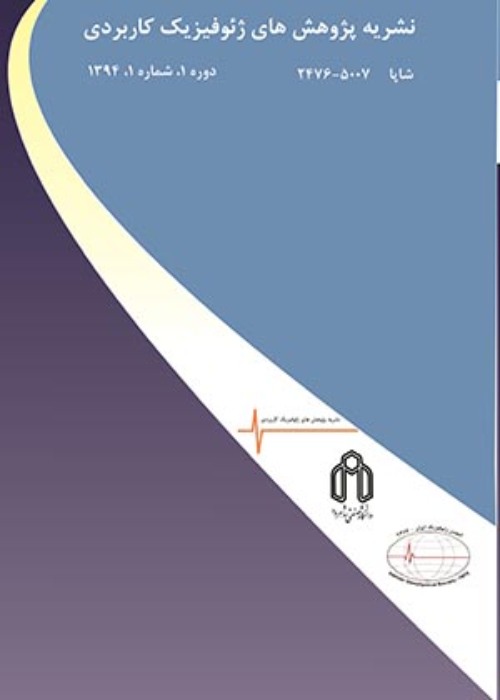Remote sensing and magnetic studies to explore geothermal resources in Sirch-Golbaf area, Kerman province
Author(s):
Abstract:
Summary: In this study, satellite images, and aeromagnetic and ground magnetic data were analyzed to explore the geothermal potential in Sirch-Golbaf area in Kerman province. Thermal anomalies and apparent thermal inertia images were studied using MODIS, Landsat and ASTER images. As a result, two thermal anomalies were obtained; one in the southeastern part of the study area and the other one in Jooshan location. Magnetic investigations also detected two anomalies; a deep magnetic anomaly in the southern part of the area and another magnetic anomaly near Jooshan hot spring in the northeastern part. These magnetic anomalies were correlated with thermal anomalies.
Methodology and Approaches: The input data in this research include MODIS, MOD11_L2 005 (day and night) reflectance and LST products, for the year 2015, ASTER L1T night-time image on November 10, 2015, Landsat ETM day-time image on November 14, 2015, aeromagnetic data collected by Houston Texas Co., USA, in 1975-1977, and geomagnetic total intensity contour map of Gowk area having 1:50000 scale, which surveyed by Atomic Energy Organization of Iran. Ground magnetic survey is also carried out in an area around Joshan hot spring. A comparison of the day-time and night-time images can reveal surface thermal differences for detecting geothermal anomalies. Land surface temperature was calculated using generalized split-window algorithm for MODIS sensor (Wan and Dozier, 1996), emissivity normalization method for ASTER (Coll et al., 2007; Banerjee et al., 2014), and LST calculation method for Landsat sensor (Barsi et al., 2003; Barsi et al., 2005; Coll et al., 2010). Apparent thermal inertia of the three sensors was calculated using albedo and LST difference of day and night (Sabol et al., 2006; Scheidt et al., 2010; Chang et al., 2012; Qin et al., 2013). After removal of noise from the observed magnetic data, processing steps including main field removal using IGRF model of the proper period, reduction to the pole, and upward continuation were applied on the magnetic data. The processed magnetic data were finally interpreted in order to locate the hidden intrusive bodies and faults.
Results and
Introduction
Remote sensing techniques are helpful reconnaissance tools for detecting surface temperature anomalies and identifying geothermal indicators (Calvin et al., 2005). Lu et al. (2008) used Landsat ETM thermal images to detect thermal anomalies strongly correlated with faults in certain scales in the Jiangshan-Shaoxing fault in the Zhejiang Province, China. They defined thermal anomalies as areas having temperatures higher than the temperature of the spatial background. In a geothermal resource exploration in Akita and Iwate prefectures, northern Japan, Noorollahi et al. (2007) showed that 95% of the production wells were located in a zone within 6000 m to the active faults and 4000 m to hot springs. Magnetic measurements are also generally used in geothermal exploration programs to locate hidden intrusive bodies and possibly estimate their depths. Moreover, they can be used to trace buried dykes and faults, and also to detect areas of reduced magnetization due to thermal activity (Georgeson, 2009). A variety of magnetic studies in geothermal exploration projects having different objectives can be found in the literature (e.g. Hojat et al., 2016; Gailler et al., 2014; Georgsson, 2009; Hunt, 1989; Palmason, 1975). The aim of this study is to analyze remote sensing and magnetic data (airborne and ground measurements) for evaluating the geothermal potential zones in an area east of Kerman Province.Methodology and Approaches: The input data in this research include MODIS, MOD11_L2 005 (day and night) reflectance and LST products, for the year 2015, ASTER L1T night-time image on November 10, 2015, Landsat ETM day-time image on November 14, 2015, aeromagnetic data collected by Houston Texas Co., USA, in 1975-1977, and geomagnetic total intensity contour map of Gowk area having 1:50000 scale, which surveyed by Atomic Energy Organization of Iran. Ground magnetic survey is also carried out in an area around Joshan hot spring. A comparison of the day-time and night-time images can reveal surface thermal differences for detecting geothermal anomalies. Land surface temperature was calculated using generalized split-window algorithm for MODIS sensor (Wan and Dozier, 1996), emissivity normalization method for ASTER (Coll et al., 2007; Banerjee et al., 2014), and LST calculation method for Landsat sensor (Barsi et al., 2003; Barsi et al., 2005; Coll et al., 2010). Apparent thermal inertia of the three sensors was calculated using albedo and LST difference of day and night (Sabol et al., 2006; Scheidt et al., 2010; Chang et al., 2012; Qin et al., 2013). After removal of noise from the observed magnetic data, processing steps including main field removal using IGRF model of the proper period, reduction to the pole, and upward continuation were applied on the magnetic data. The processed magnetic data were finally interpreted in order to locate the hidden intrusive bodies and faults.
Results and
Conclusions
Two thermal anomalies were detected on the maps and charts obtained for the average temperature difference (day and night) and apparent thermal inertia. One anomaly was located in the Jooshan area and the other one was situated in the western part of Gowk fault and continues along it to the southeastern side. Gowk fault is an active fault with Jooshan (45 C) hot spring, and most earthquakes larger than magnitude 5 have occurred in this part. These might be evidences of a thermal anomaly. The results of magnetic interpretations confirmed thermal anomalies showing a deep magnetic anomaly in the southern part of the study area and another magnetic anomaly in the Jooshan hot spring.Keywords:
Language:
Persian
Published:
Journal Of Research on Applied Geophysics, Volume:3 Issue: 1, 2017
Pages:
99 to 118
https://magiran.com/p1707320
مقالات دیگری از این نویسنده (گان)
-
Sub-pixel Mineral Mapping of Serpentine and Magnesite for Chromite Exploration, Using Hyperion (EO1) Images
Saeed Khojastehfar *, Hojatallah Ranjbar, Shahram Shafiei Bafti
Journal of Aalytical and Numerical Methods in Mining Engineering, Summer 2023 -
Tephra, Lava flow, Nuee Ardente and Lahar Hazard Zoning of Damavand Volcano
Ahmad Khaiatzadeh, Ahmad Abbasnejad *, Hojjatolah Ranjbar, Hamid Ahmadipour, Behnam Abbasnejad
Geosciences Scientific Quarterly Journal, -
Curie point depth from spectral analysis of aeromagnetic data for reconnaissance exploration of geothermal potential; Case study: east of Kerman Province
MohammadFahim Avish, , Azadeh Hojat *, Saeed Karimi Nasab
Journal of the Earth and Space Physics, -
اکتشاف لایه های اشباع آب زیرسطحی با استفاده از داده های ژئوالکتریک و IP در مناطق شهری
*، غلامرضا کمالی
نشریه صنعت مقاوم سازی و بهسازی، پاییز و زمستان 1394




